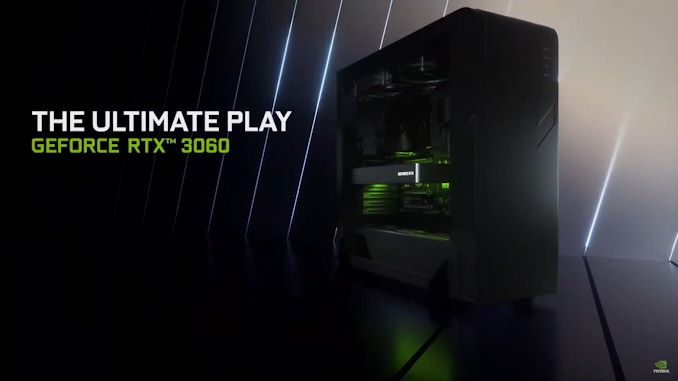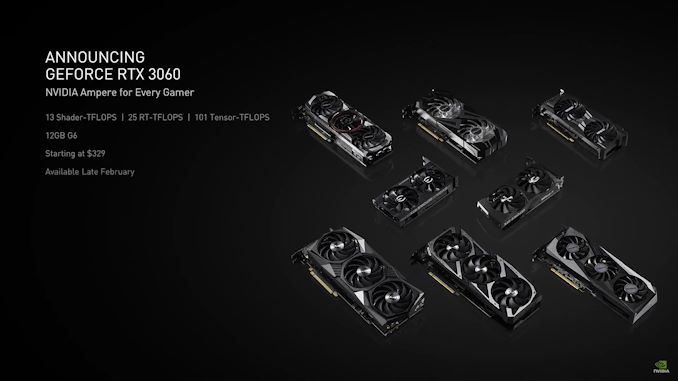NVIDIA’s GeForce RTX 3060 Gets a Release Date: February 25th
by Ryan Smith on February 12, 2021 12:30 PM EST- Posted in
- GPUs
- NVIDIA
- GeForce RTX
- Ampere
- RTX 3060

NVIDIA this morning has sent over a quick note revealing the release date for their next GeForce desktop video card, the RTX 3060. The mainstream(ish) video card, previously revealed at CES 2021 with a late February release date, has now been locked in for a launch on February 25th, with prices starting at $329.
As a quick recap, the RTX 3060 is the next card down in NVIDIA’s Ampere architecture consumer video card stack. Using the new GA106 GPU – which is already shipping in RTX 3060 laptops – the RTX 3060 follows the traditional price/performance cadence for video card launches, with NVIDIA releasing a cheaper and lower performing video card for the mainstream-enthusiast video card market. NVIDIA’s 60-tier cards have long been the company’s workhorse parts for 1080p gaming – as well as some of their highest-volume parts in North America – and the RTX 3060 is expected to fill the same role within the Ampere/30-series family.
| NVIDIA GeForce Specification Comparison | ||||||
| RTX 3060 | RTX 3060 Ti | RTX 2060 | GTX 1060 | |||
| CUDA Cores | 3584 | 4864 | 1920 | 1280 | ||
| ROPs | 64? | 80 | 48 | 48 | ||
| Boost Clock | 1.78GHz | 1.665GHz | 1.68GHz | 1.709GHz | ||
| Memory Clock | 14Gbps? GDDR6 | 14Gbps GDDR6 | 14Gbps GDDR6 | 8Gbps GDDR5 | ||
| Memory Bus Width | 192-bit | 256-bit | 192-bit | 192-bit | ||
| VRAM | 12GB | 8GB | 6GB | 6GB | ||
| Single Precision Perf. | 12.8 TFLOPS | 16.2 TFLOPS | 6.5 TFLOPS | 4.4 TFLOPS | ||
| Tensor Perf. (FP16) | 51.2 TFLOPS | 64.8 TFLOPS | 51.6 TFLOPS | N/A | ||
| Tensor Perf. (FP16-Sparse) | 102.4 TFLOPS | 129.6 TFLOPS | 51.6 TFLOPS | N/A | ||
| TDP | 170W | 200W | 160W | 120W | ||
| GPU | GA106 | GA104 | TU106 | GP106 | ||
| Transistor Count | ?B | 17.4B | 10.8B | 4.4B | ||
| Architecture | Ampere | Ampere | Turing | Pascal | ||
| Manufacturing Process | Samsung 8nm? | Samsung 8nm | TSMC 12nm "FFN" | TSMC 16nm | ||
| Launch Date | 02/25/2021 | 12/02/2020 | 01/15/2019 | 07/19/2016 | ||
| Launch Price | MSRP: $329 | MSRP: $399 | MSRP: $349 | MSRP: $249 Founders $299 |
||
NVIDIA has already published most of the specifications for the card back in January. Including the fact that it offers 28 SMs (3584 CUDA cores), and 12GB of GDDR6 running on a 192-bit memory bus. As with previous 60-tier cards, the non-power-of-two memory bus means that NVIDIA is shipping with a somewhat odd amount of memory, in this case 12GB, which is actually more than what comes on even the RTX 3080. However with the only other option being an anemic-for-2021 6GB, NVIDIA is opting to make sure that the card isn’t for want of VRAM capacity.
Meanwhile, for better or worse the RTX 3060 is all-but-guaranteed to fly off of shelves quickly. With every video card more powerful than a GTX 1050 Ti seemingly getting shanghaied into mining Ethereum, desperate gamers will be fighting with hungry miners for supplies. Even with the 192-bit memory bus, I would be shocked if the RTX 3060 wasn’t profitable, especially with Ethereum reaching record highs. So for anyone thinking of grabbing the card, best be prepared to camp out at your favorite retailer or e-tailer on that Thursday morning.
On a final note, unlike the other RTX 30 series cards launched to date, NVIDIA will not be producing any Founders Edition cards for the RTX 3060 series. So all of the cards released will be AIB cards with their own respective designs. And, if tradition holds, don't be surprised if we see the AIBs outfit their cards with premium features and raise their prices accordingly.











73 Comments
View All Comments
evilspoons - Friday, February 12, 2021 - link
For a fair comparison, remember the 5870 is 11 1/2 years old at this point. A $399 card is now a $499 card just by inflation.prime2515103 - Friday, February 12, 2021 - link
Inflation from 2010 through 2020 was a total of 3.538%. If you want to add 2000 to 2009, that's another 2.54% for a total of 6.07%. This does not account for a 25% price increase.ManuelDiego - Friday, February 12, 2021 - link
More like 20% (https://www.in2013dollars.com/us/inflation/2010?am... from 2010 to 2020. 52% from 2000 to 2020 (all of this is for the US, i'm assuming). So yes, a $400 gpu of 10 years ago is today a $500 just by inflationSeeing as you just seem to be adding the rates, i don't think you understand what a compound interest is.
fcth - Friday, February 12, 2021 - link
Yeah, no. I don't know where you are getting that number but it is way, way off. The Fed targets inflation at 2%, and while we haven't always hit that over the past decade, a six percent figure over two decades is absurdly low.According to the Bureau of Labor Statistics, inflation in the Consumer Price Index since September 2009 (when the Radeon 5870 launched) is 21%. This mean that the Radeon 5870 launch price of $379 would be $459 in 2021 dollars.
Spunjji - Monday, February 15, 2021 - link
$486.50, to be precise, which would nearly get you a 3070 at its theoretical MSRP, and in reality get you a 3060 Ti with a little change (if you could find it in stock).Spunjji - Monday, February 15, 2021 - link
Although the 5870 was a $379 card, so that's actually $462 now. Oof.FatFlatulentGit - Friday, February 12, 2021 - link
I'm still baffled by the lowest end card having more VRAM than all but the highest end card.krazyfrog - Friday, February 12, 2021 - link
The way I see it, NVIDIA's previous 30-series launches happened before AMD announced its 6000 series cards with 16GB memory all-around. That had to have caused NVIDIA to rethink its strategy and so all new launches going forward should hopefully have more VRAM.FatFlatulentGit - Friday, February 12, 2021 - link
But they're still behind on the 3070 and 3080, which just looks really weird. There were rumors of 20GB versions, but those have yet to materialize. Then again, all of these cards seem to have difficulty materializing these days.fcth - Friday, February 12, 2021 - link
I'm still guessing that Nvidia originally was planning more VRAM on the higher-end cards, but then GDDR6X prices were too expensive so they cut their allocations in half, given that few current applications need that much RAM. GDDR6 isn't as bad (the Radeon 5500 XT I bought last year for $200 has 8GB of GDDR6), but they also cut down the 3070's allocation so as to not embarrass the high-end cards. But for the 3060, 6GB was really not going to be enough, current games can fill that, to say nothing of future titles, so they were stuck with either going to 12GB or going with a wider bus to accommodate 8GB (and ended up doing both).